FIAT DUCATO BASE CAMPER 2016 Owner handbook (in English)
Manufacturer: FIAT, Model Year: 2016, Model line: DUCATO BASE CAMPER, Model: FIAT DUCATO BASE CAMPER 2016Pages: 387, PDF Size: 20.76 MB
Page 161 of 387
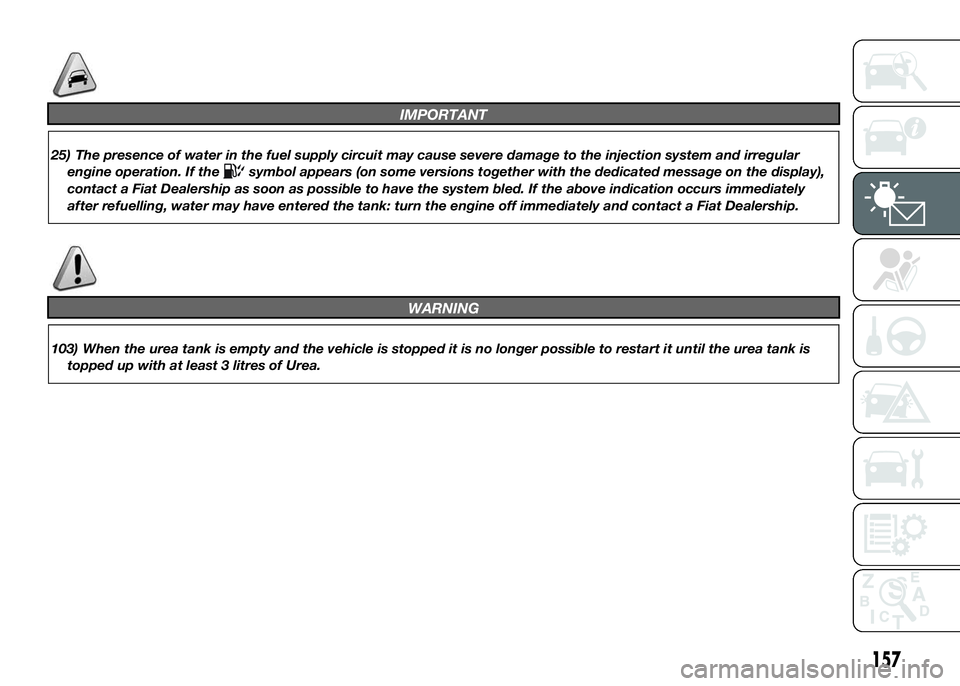
IMPORTANT
25) The presence of water in the fuel supply circuit may cause severe damage to the injection system and irregular
engine operation. If the
symbol appears (on some versions together with the dedicated message on the display),
contact a Fiat Dealership as soon as possible to have the system bled. If the above indication occurs immediately
after refuelling, water may have entered the tank: turn the engine off immediately and contact a Fiat Dealership.
WARNING
103) When the urea tank is empty and the vehicle is stopped it is no longer possible to restart it until the urea tank is
topped up with at least 3 litres of Urea.
157
Page 162 of 387
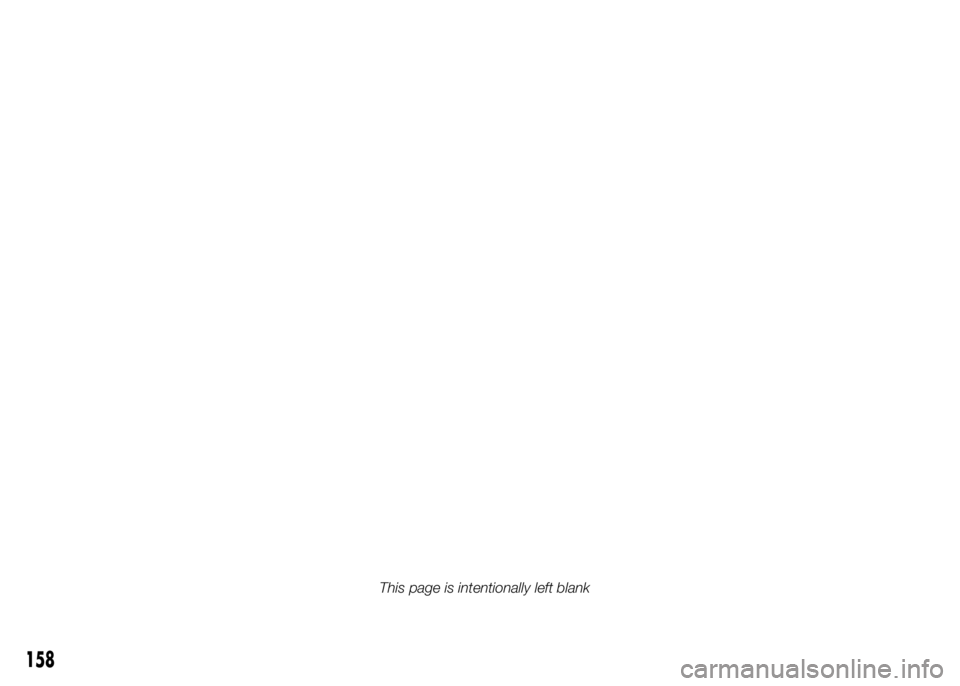
158
This page is intentionally left blank
Page 163 of 387
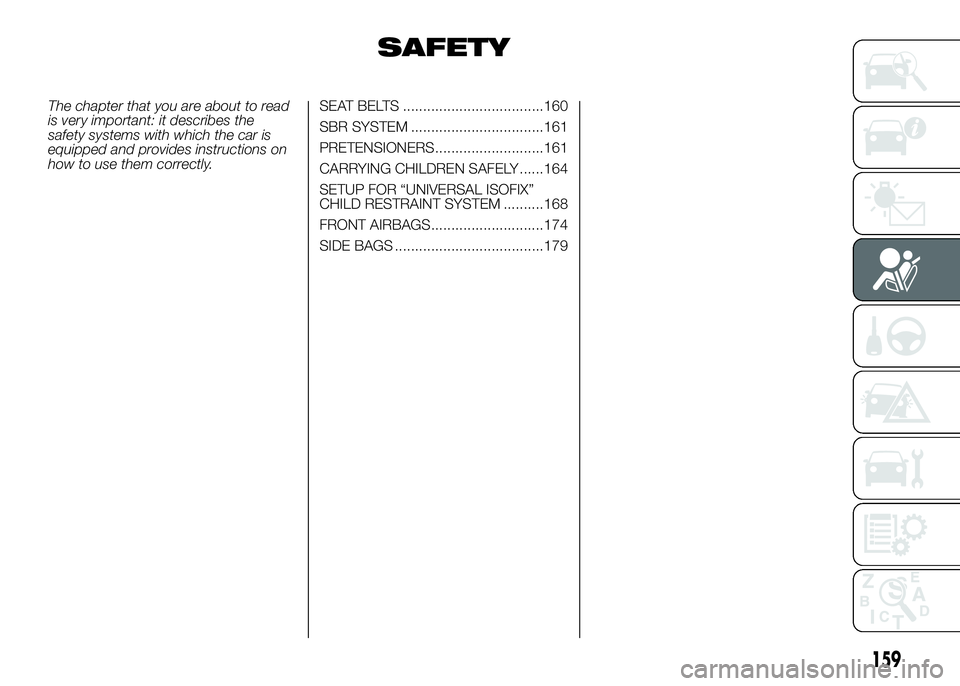
SAFETY
The chapter that you are about to read
is very important: it describes the
safety systems with which the car is
equipped and provides instructions on
how to use them correctly.SEAT BELTS ...................................160
SBR SYSTEM .................................161
PRETENSIONERS...........................161
CARRYING CHILDREN SAFELY ......164
SETUP FOR “UNIVERSAL ISOFIX”
CHILD RESTRAINT SYSTEM ..........168
FRONT AIRBAGS............................174
SIDE BAGS .....................................179
159
Page 164 of 387
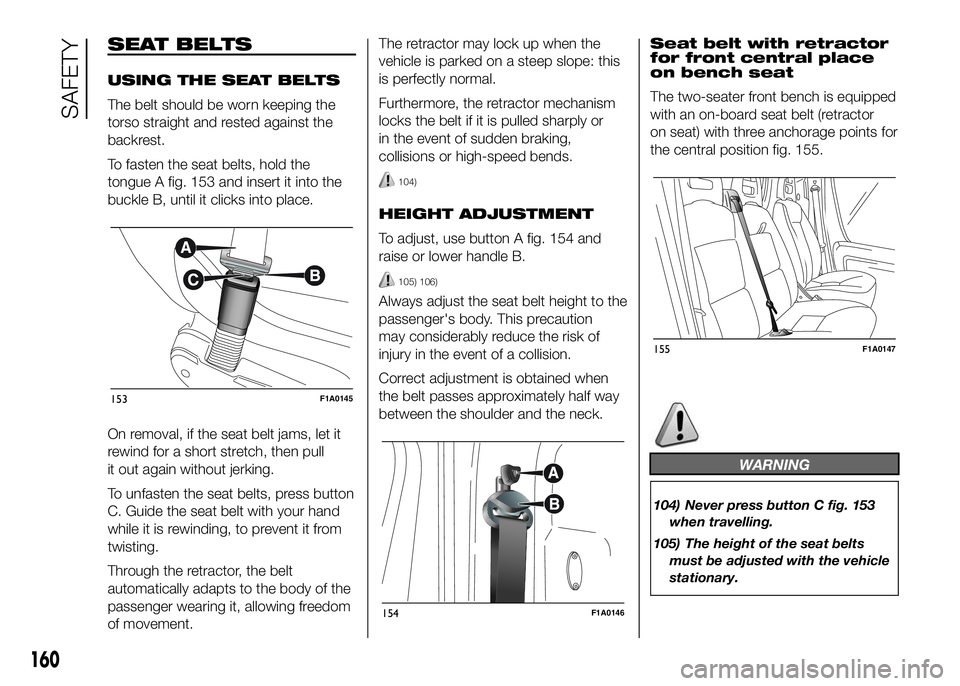
SEAT BELTS
USING THE SEAT BELTS
The belt should be worn keeping the
torso straight and rested against the
backrest.
To fasten the seat belts, hold the
tongue A fig. 153 and insert it into the
buckle B, until it clicks into place.
On removal, if the seat belt jams, let it
rewind for a short stretch, then pull
it out again without jerking.
To unfasten the seat belts, press button
C. Guide the seat belt with your hand
while it is rewinding, to prevent it from
twisting.
Through the retractor, the belt
automatically adapts to the body of the
passenger wearing it, allowing freedom
of movement.The retractor may lock up when the
vehicle is parked on a steep slope: this
is perfectly normal.
Furthermore, the retractor mechanism
locks the belt if it is pulled sharply or
in the event of sudden braking,
collisions or high-speed bends.
104)
HEIGHT ADJUSTMENT
To adjust, use button A fig. 154 and
raise or lower handle B.
105) 106)
Always adjust the seat belt height to the
passenger's body. This precaution
may considerably reduce the risk of
injury in the event of a collision.
Correct adjustment is obtained when
the belt passes approximately half way
between the shoulder and the neck.Seat belt with retractor
for front central place
on bench seat
The two-seater front bench is equipped
with an on-board seat belt (retractor
on seat) with three anchorage points for
the central position fig. 155.
WARNING
104) Never press button C fig. 153
when travelling.
105) The height of the seat belts
must be adjusted with the vehicle
stationary.
153F1A0145
154F1A0146
155F1A0147
160
SAFETY
Page 165 of 387
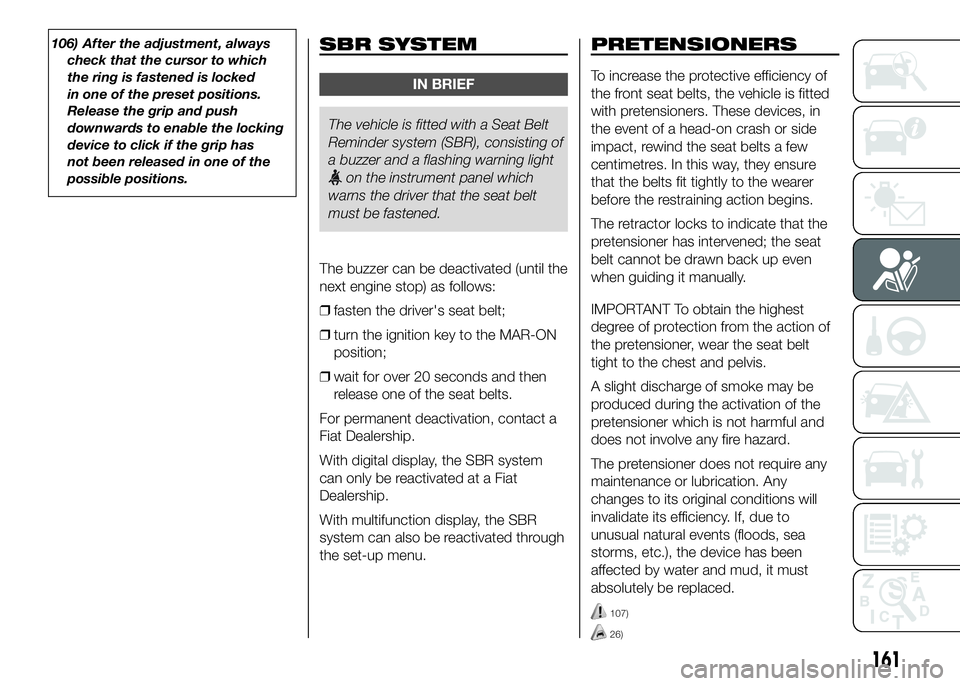
106) After the adjustment, always
check that the cursor to which
the ring is fastened is locked
in one of the preset positions.
Release the grip and push
downwards to enable the locking
device to click if the grip has
not been released in one of the
possible positions.SBR SYSTEM
IN BRIEF
The vehicle is fitted with a Seat Belt
Remindersystem (SBR), consisting of
a buzzer and a flashing warning light
on the instrument panel which
warns the driver that the seat belt
must be fastened.
The buzzer can be deactivated (until the
next engine stop) as follows:
❒fasten the driver's seat belt;
❒turn the ignition key to the MAR-ON
position;
❒wait for over 20 seconds and then
release one of the seat belts.
For permanent deactivation, contact a
Fiat Dealership.
With digital display, the SBR system
can only be reactivated at a Fiat
Dealership.
With multifunction display, the SBR
system can also be reactivated through
the set-up menu.
PRETENSIONERS
To increase the protective efficiency of
the front seat belts, the vehicle is fitted
with pretensioners. These devices, in
the event of a head-on crash or side
impact, rewind the seat belts a few
centimetres. In this way, they ensure
that the belts fit tightly to the wearer
before the restraining action begins.
The retractor locks to indicate that the
pretensioner has intervened; the seat
belt cannot be drawn back up even
when guiding it manually.
IMPORTANT To obtain the highest
degree of protection from the action of
the pretensioner, wear the seat belt
tight to the chest and pelvis.
A slight discharge of smoke may be
produced during the activation of the
pretensioner which is not harmful and
does not involve any fire hazard.
The pretensioner does not require any
maintenance or lubrication. Any
changes to its original conditions will
invalidate its efficiency. If, due to
unusual natural events (floods, sea
storms, etc.), the device has been
affected by water and mud, it must
absolutely be replaced.
107)
26)
161
Page 166 of 387

LOAD LIMITERS
To increase passenger safety, the front
seat belt retractors contain a load
limiter which controls the force acting
on the chest and shoulders during
the belt restraining action in the event of
a head-on collision.
GENERAL
INSTRUCTIONS FOR
USING THE SEAT BELTS
The driver is responsible for respecting
(and ensuring that all the other
passengers also respect) the local laws
in force regarding the use of seat belts.
Always fasten the seat belts before
setting off.
Seat belts are also to be worn by
pregnant women: the risk of injury in
the case of accident is greatly reduced
for them and the unborn child if they
are wearing a seat belt. Pregnant
women must position the lower part of
the belt very low down so that it passes
over the pelvis and under the
abdomen (see fig. 156).
108) 109) 110) 111) 112)
SEAT BELTS
MAINTENANCE
For keeping the seat belts in efficient
conditions, carefully observe the
following:
❒always use the seat belt well
stretched and never twisted; make
sure that it is free to run without
obstructions;
❒replace the belt after an accident of a
certain severity even if it does not
appear to be damaged. Always
replace the belt if the pretensioners
were deployed;
❒to clean the belt, wash by hand with
water and mild soap, rinse and leave
to dry in the shade. Never use strong
detergents, bleach, paints or any
other substance which could
damage the belt fibres;
❒prevent the retractors from getting
wet: their correct operation is only
guaranteed if water does not get
inside;
❒replace the seat belt when it shows
wear or cuts.
156F1A0148
157F1A0149
158F1A0150
162
SAFETY
Page 167 of 387

WARNING
107) The pretensioner may be used
only once. After it is triggered,
have it replaced at a Fiat
Dealership.
108) The belt must not be twisted.
The upper part must pass over
the shoulder and cross the chest
diagonally. The lower part must
adhere to the pelvis (as shown in
fig. 157) rather than the abdomen
of the passenger. Never use
devices (clips, clamps, etc.) that
hold the seat belt away from your
body.
109) For maximum protection, keep
the backrest upright, lean back
into it and make sure the seat belt
fits closely across your chest
and pelvis. Always fasten the seat
belts on both the front and the
rear seats! Travelling without
wearing seat belts will increase
the risk of serious injury and even
death in the event of an accident.110) Removing or otherwise
tampering with seat belt and
pretensioner components is
strictly prohibited. Any operations
on these components must be
performed by qualified and
authorised technicians. Always go
to a Fiat Dealership.
111) If the belt has been subjected
to a high level of stress, for
example after an accident, it must
be completely replaced together
with the attachments, attachment
fixing screws and the
pretensioner. In fact, even if the
belt has no visible defects, it could
have lost its resilience.
112) Each seat belt must be used by
only one person. Never travel with
a child sitting on the passenger's
lap and a single belt to protect
them both fig. 158. In general, do
not place any objects between the
person and the belt.
IMPORTANT
26) Operations which lead to
impacts, vibrations or localised
heating (over 100°C for a
maximum of six hours) in the area
around the pretensioners may
damage or accidentally deploy
them. Contact a Fiat Dealership
should intervention be necessary
on these components.
163
Page 168 of 387
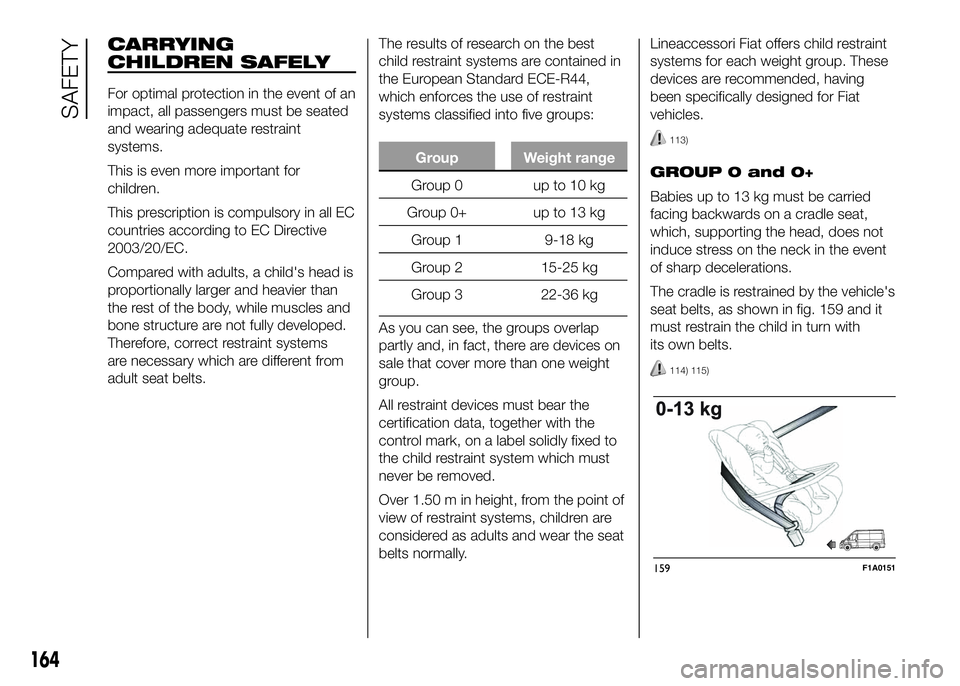
CARRYING
CHILDREN SAFELY
For optimal protection in the event of an
impact, all passengers must be seated
and wearing adequate restraint
systems.
This is even more important for
children.
This prescription is compulsory in all EC
countries according to EC Directive
2003/20/EC.
Compared with adults, a child's head is
proportionally larger and heavier than
the rest of the body, while muscles and
bone structure are not fully developed.
Therefore, correct restraint systems
are necessary which are different from
adult seat belts.The results of research on the best
child restraint systems are contained in
the European Standard ECE-R44,
which enforces the use of restraint
systems classified into five groups:
Group Weight range
Group0 upto10kg
Group 0+ up to 13 kg
Group 1 9-18 kg
Group 2 15-25 kg
Group 3 22-36 kg
As you can see, the groups overlap
partly and, in fact, there are devices on
sale that cover more than one weight
group.
All restraint devices must bear the
certification data, together with the
control mark, on a label solidly fixed to
the child restraint system which must
never be removed.
Over 1.50 m in height, from the point of
view of restraint systems, children are
considered as adults and wear the seat
belts normally.Lineaccessori Fiat offers child restraint
systems for each weight group. These
devices are recommended, having
been specifically designed for Fiat
vehicles.
113)
GROUP 0 and 0+
Babies up to 13 kg must be carried
facing backwards on a cradle seat,
which, supporting the head, does not
induce stress on the neck in the event
of sharp decelerations.
The cradle is restrained by the vehicle's
seat belts, as shown in fig. 159 and it
must restrain the child in turn with
its own belts.
114) 115)
159F1A0151
164
SAFETY
Page 169 of 387
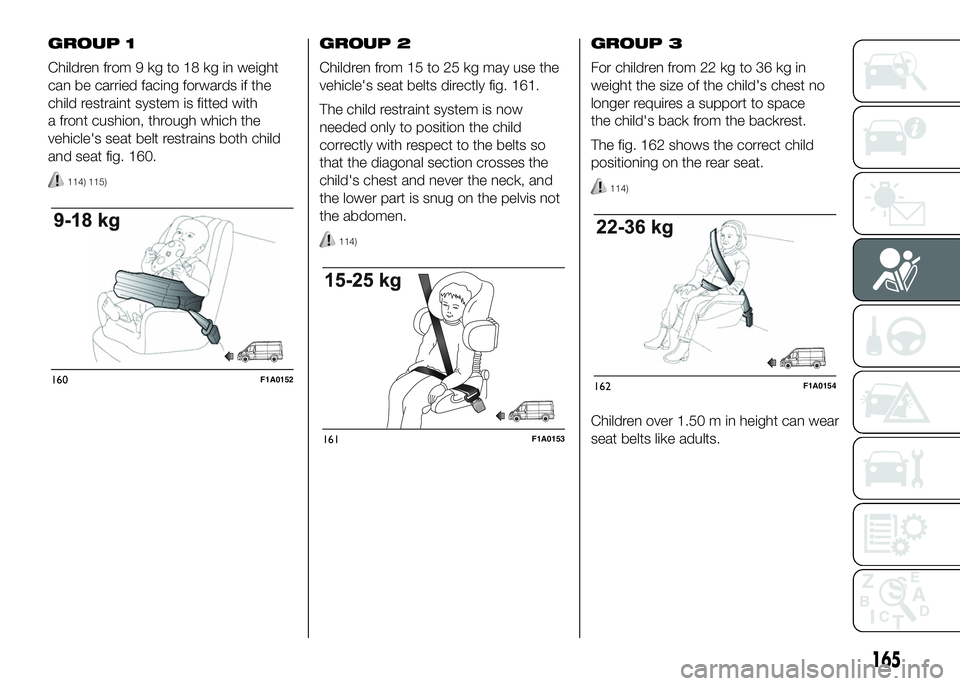
GROUP 1
Children from 9 kg to 18 kg in weight
can be carried facing forwards if the
child restraint system is fitted with
a front cushion, through which the
vehicle's seat belt restrains both child
and seat fig. 160.
114) 115)
GROUP 2
Children from 15 to 25 kg may use the
vehicle's seat belts directly fig. 161.
The child restraint system is now
needed only to position the child
correctly with respect to the belts so
that the diagonal section crosses the
child's chest and never the neck, and
the lower part is snug on the pelvis not
the abdomen.
114)
GROUP 3
For children from 22 kg to 36 kg in
weight the size of the child's chest no
longer requires a support to space
the child's back from the backrest.
The fig. 162 shows the correct child
positioning on the rear seat.
114)
Children over 1.50 m in height can wear
seat belts like adults.
160F1A0152
161F1A0153
162F1A0154
165
Page 170 of 387

SUITABILITY OF PASSENGER SEATS FOR THE USE OF CHILD RESTRAINT
SYSTEMS
The vehicle complies with the new European Directive 2000/3/EC which governs the arrangement possibilities for child restraint
systems on the seats of a vehicle as shown in the following table (the table refers to the Van, Combi and Panorama versions):
Group Weight range CAB 1st and 2nd REAR SEATS ROW
Single or two-
seaterseat (1 or 2
passengers)Rear left side
passengerRear right side
passengerCentral passenger
Group 0, 0+ Up to 13 kgUUUU
Group 1 9–18 kgUUUU
Group 2 15–25 kgUUUU
Group 3 22–36 kgUUUU
U suitable for child restraint systems in the "Universal" category, according to European Standard ECE-R44 for the specified "Groups".
166
SAFETY